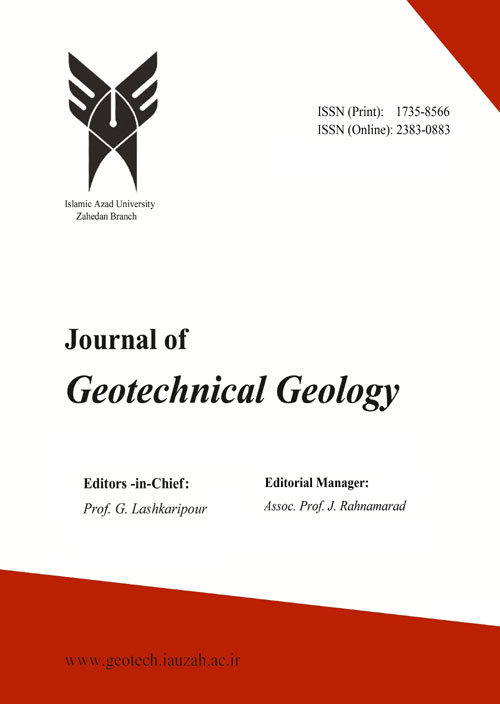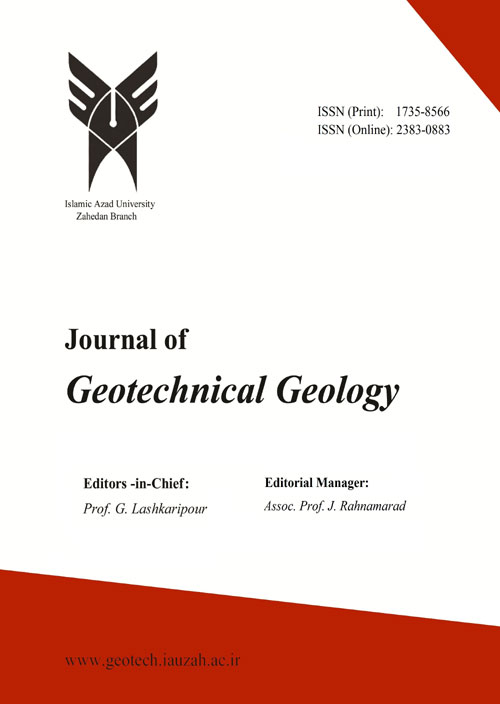فهرست مطالب

Journal of Geotechnical Geology
Volume:17 Issue: 1, Winter and Spring 2021
- تاریخ انتشار: 1400/04/06
- تعداد عناوین: 6
-
Pages 435-441
The performance of piles in liquefied soils is much more complex than the performance of piles in non-liquefied soils; Because in this case, in addition to the fact that the pile is subjected to different dynamic loads, both from the structure and from the soil, the strength and hardness of the soil decreases over time due to nonlinear behavior of the soil and increasing pore water pressure. And several numerical analyzes have been done in this field, the mechanism of interaction of the structure-soil pile set during liquefaction has not been determined yet. Thus, the presented study attempted to provide the numerical modeling to understand the piles behavior in liquefied soils. In this regard, the finite element codes by Plaxis software was use to simulate and extract the deformation status for piles constructed on deep liquefied soils. According to the prepared modeling successfully used for deformation, liquefaction, and piles performance analyses.
Keywords: Liquefaction, Pile bearing capacity, Numerical modeling, Water pore-pressure, PLAXIS -
Pages 443-453Special concrete frames are designed to withstand the bending loads caused by earthquakes, and how to reinforce them is debatable. In this study, the effect of a type of these frames that are reinforced with FRP composite reinforcements was discussed. The research was conducted by finite element method and after validation with a real sample and checking the convergence of the results, permission to use this method was issued. The result was that the loads caused by earthquakes, which affect the structures in the form of bending and shear, despite the need for proper resistance to repel the effect, need a little flexibility in movement so that such loads do not cause material fatigue. FRP reinforcements, due to their good flexibility, provide limited movement of the frame, so fewer loads is applied to it and proper connection between the members also eliminates danger. Thus, structures with a suitable safety factor and bending and shear loads will not be able to pose a hazard. A comparison was made between the effects of metal reinforcement and composite reinforcement, which proved to be positive. Special concrete type also showed good resistance to severe seismicity and was considered suitable for construction in seismic areas.Keywords: Composite reinforcement, Concrete frames, Column connection, dynamic loading
-
Pages 455-463The presented article provides a comprehensive review of rocking foundations and related works. The purpose of review studies is to carefully recognize the related literature to evaluate a particular research question, substantive domain, theoretical approach, or methodology and, in this way, to provide readers with a state-of-the-art understanding of the research topic. In this paper, the viewpoint of significant geotechnical undertaking, methods, techniques and their disadvantages and restrictions are discussed. This assignment focuses on rocking foundation procedure as an important task with performing the high-rise loading platforms on buildings and bridges under seismic conditions with shallow foundations. Giving an introduction to the methodology, the theoretical foundations and background of studies in this field are expressed in this respect. The perspective of this approach is then explored based on the geotechnical aspects of rocking foundations.Keywords: Geotechnics, Rocking foundations, soil, Surface foundations, seismic loading
-
Pages 465-470
Improving the engineering properties of soils by chemical stabilization and using reinforcement material are means of complying with geotechnical design criteria. Nowadays, the use of chemical materials such as Portland cement and lime has been criticized despite the acceptable effect due to environmental pollution caused by their production as well as the contamination caused by these materials in the soil. One of the materials used to replace cement and lime is cement kiln dust (CKD), which has been used as filler in asphalt concrete, sewage sludge stabilization, and improving the physical and mechanical properties of soils in recent years. An experimental study was performed to evaluate strength behavior and microstructural characteristics of CKD-soil admixture reinforced by polypropylene fibers. The effect of content and length of fibers on mixture properties was investigated. The results indicated that CKD increases the strength of the soil, but its behavior is fragile. The use of fiber in combination with CKD, in addition to increasing the strength, makes the sample more ductile. The test results showed that the optimum content of polypropylene fibers is 0.5%. The failure pattern of fiber-reinforced specimens differed from that of fiberless specimens due to the bridge effect. The results of the UCS test agreed well with the results from the SEM analysis.
Keywords: Soil Stabilization, Cement kiln dust, polypropylene fiber, Compressive Strength -
Pages 471-478The growth and development of industries have led to expanding suburban factories, complexes, refineries, and oil product transportation lines, causing environmental concerns and repercussions due to the leakage and discharge of pollutions into potable water resources. These contaminations can change the geotechnical characteristics and bearing capacity of soils. This study determined the behavior of circular footings rested on the gasoil and kerosene-contaminated soil. In addition, the obtained results comprised those collected from the uncontaminated soil. The study mainly attempted to determine the effect of oil contamination on the bearing capacity of oil-contaminated sand based on the numerical model created in the PLAXIS. The contaminated sand layers were mixed with varying gasoil and kerosene contaminations levels (1%-4%). Direct shear tests were conducted on the contaminated soil samples to determine the shear strength parameter utilized in numerical analysis. The influences of the contamination depth and type were examined. The numerical model results indicated the negative relationship between the percentage and the depth of contamination with gasoil and Kerosene and the circular foundation bearing capacities; an increase in the first two criteria reduced the later property in the soil. This paper proposed several equations to predict the bearing capacity of a circular foundation based on depth and percentage of contamination. The numerical model used had been verified by recent experimental results.Keywords: Oil Contamination, bearing capacity, Load-settlement curve, Circular foundation, numerical analysis
-
Pages 479-486The presented article tried to estimate the human recourses’ effects on time managements of high-rise buildings projects in urban area which is implemented on Tehran city construction projects. For this purpose, statistical analysis with the random population and the sample population of about 200 people has been used. The research variables which are integration management, project management’s scope, human resource management, project communication, project risk management, time management, quality management, procurement management are first tested for their normality which has been done using SPSS software. The results of the research are classified after statistical evaluation and the conditions of their statistical distribution are extracted.Keywords: Time managements, High-rise buildings, Construction management, Urban projects, Tehran


